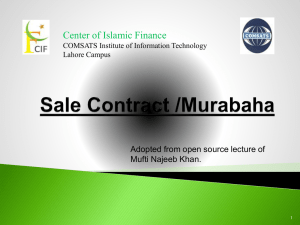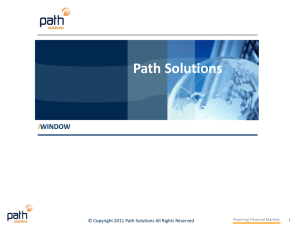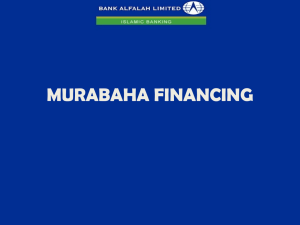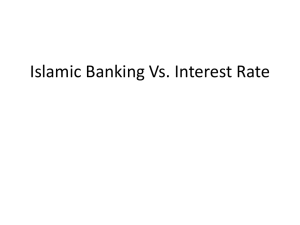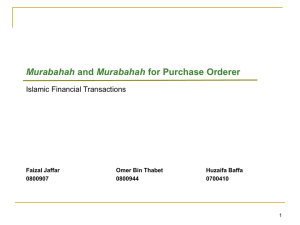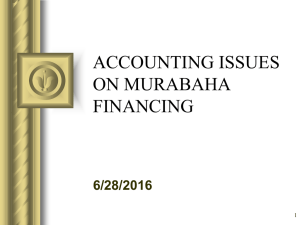MURABAHA FINANCE MUHAMMAD TAYYAB RAZA A PRESENTATION BY:
advertisement
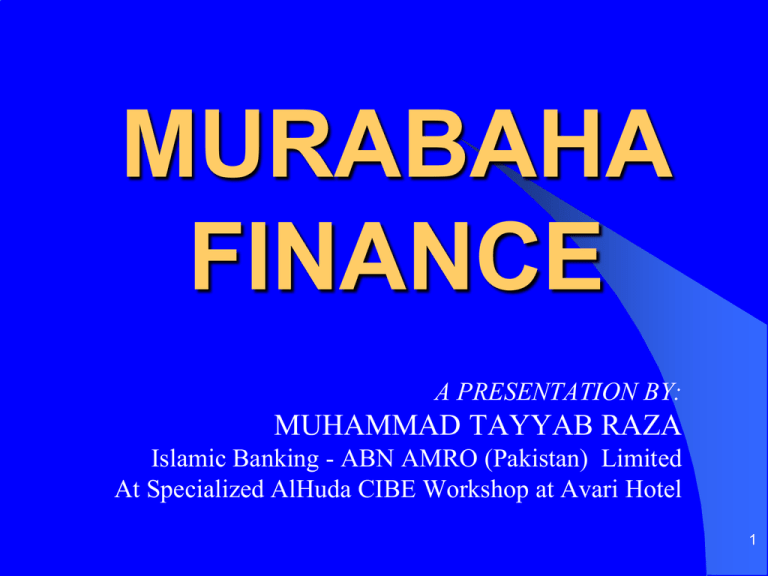
MURABAHA FINANCE A PRESENTATION BY: MUHAMMAD TAYYAB RAZA Islamic Banking - ABN AMRO (Pakistan) Limited At Specialized AlHuda CIBE Workshop at Avari Hotel 1 LEARNING OBJECTIVES Conceptual understanding of Murabaha Stages involved in Murabaha Transaction Practical issues in Murabaha and their resolution Murabaha Documentation Uses of Murabaha as Mode of Finance (Local as well as import Murabaha) 2 DERIVATION OF MURABAHA The word “Murabaha” has been derived from the Arabic word “Ribah”, which has literary meaning of profit. The Murabaha can be denoted as “Sale With Profit”. 3 DEFINITION OF MURABAHA Murabaha is a particular kind of sale where Seller expressly mentions the cost it has incurred on purchase of the Asset(s) to be sold and sells it to another person by adding some profit, which is known to Buyer. 4 WHAT IS SALE? Sale is defined in the Islamic Fiqh as follows: “Exchange of a thing(subject matter) of value with another thing of value, with mutual consent”. 5 COMPONENTS OF VALID SALE SALE CONTRACT •Offer/Acceptance •Buyer/Seller SUBJECT MATTER •Existence •Ownership •Possession PRICE POSSESSION •Quantified •Certain •Physical •Constructive •Valuable •Specific •Halal Purpose •Delivery Instant and absolute Unconditional 6 FEATURES OF MURABAHA Murabaha finance is not a loan given on interest, it is a sale of Asset(s) for cash/deferred price. It is the obligation of the Seller to disclose the Cost and Profit to the Buyer. 7 FEATURES OF MURABAHA Murabaha Finance can only be used for the purchase of fresh Asset(s) only. Buy-Back arrangement is prohibited. This means that Murabaha transaction cannot be executed for the Asset(s) already purchased by the Customer. 8 FEATURES OF MURABAHA Murabaha Transaction can either be a cash sale (Spot Payment Murabaha) or a credit sale (Deferred Payment Murabaha) or a combination of both. Payment of Murabaha Price can be made in lump sum or in installments or combination of both. 9 FEATURES OF MURABAHA It is a fixed price sale and normally is done for short term. The Murabaha Finance can be used to meet the working capital requirements. However, it cannot be used to meet the liquidity requirements. 10 VARIOUS MODELS OF MURABAHA FINANCE 11 MODEL - I TWO PARTY REALTIONSHIP Bank – Customer MODEL - II THREE PARTY RELATIONSHIP (Bank-Vendor) and Customer MODEL - III THREE PARTY RELATIONSHIP Bank and (Vendor-Customer) 12 MODEL - I The simplest possible Model emerges when the transaction involves two parties only, i.e Bank and the Customer. The Bank is also vendor and sells the Asset(s) to its Customers on deferred payment basis. Shari’ah perspective it is an ideal Model and its profits are fully justified because Bank assumes all risks as Vendor/Trader. From 13 MODEL I – GRAPHICAL PRESENTATION 2 1 Customer Bank/Vendor 3 14 MODEL I - PHASES Phase 1: The customer approaches Bank (Vendor) and identifies Asset(s) and collects relevant information including cost and profit. Phase 2: Bank sells Asset(s) to the Customer, transfer risk and ownership to the Customer at certain Murabaha Price. Phase 3: Customer pays Murabaha Price in lump sum or in installments on agreed dates. 15 MODEL - II In most cases Murabaha Transaction involves a third party (i.e. Vendor) because Bank is not expected to engage in sale of variety of products required for variety of Customers. The Bank directly deals with the Vendor and purchases the Asset(s). 16 MODEL II The Bank sells the purchased Asset(s) to the customer on cost plus basis. There are two distinct sale contracts at different point of times. First between Bank and Vendor and second between Bank and the Customer. 17 MODEL II – GRAPHICAL PRESENTATION 3 1 4 Vendor 5 2 6 Customer Bank 18 MODEL II - PHASES Phase 1: Customer identifies and approaches the Vendor or Supplier of the Asset(s) and collects all relevant information. Phase 2: Customer approaches the Bank for Murabaha Financing and promises to buy the Asset(s). Phase 3: The Bank makes payment to vendor directly. 19 MODEL II – PHASES Phase 4: Vendor delivers the Asset(s) & transfers the ownership of Asset(s) to the Bank. Phase 5: Bank sells the Asset(s) to Customer on cost plus basis and transfers ownership. Phase 6: Customer pays Murabaha Price in lump sum or in installments on agreed dates. 20 MODEL III – BANKING MURABAHA This Murabaha Model is mostly practiced model in Banking now a days and therefore we will look at it in more detail. We will also look at the documentation required at different stages of the transaction. It is also a three-party structure but it is bit complicated than previous ones. 21 MODEL III – BANKING MURABAHA The product of Murabaha that is being used in Islamic Banking as a mode of finance is something different from the Murabaha used in normal trade . It is called Murabaha to the Purchase Orderer . 22 MODEL III – BANKING MURABAHA It is a bunch of contracts completed in steps and ultimately suffices the financial needs of the client. THE SEQUENCE OF THEIR EXECUTION IS EXTREMELY IMPORTANT TO MAKE THE TRANSACTION SHARIA’H COMPLIANT. 23 MODEL III – GRAPHICAL PRESENTAION 3 4 Vendor 5 5 2 6 Customer Offer Acceptance 1 7 Bank 24 PHASE I – PROMISE TO PURCHASE AND SELL The Customer approaches the Bank for Murabaha Finance and promises to purchase the Asset(s) from the Bank which, the Customer will purchase as an Agent of the Bank. Master Murabaha Finance Agreement (MMFA) shall be signed by the Bank and the Customer at this stage. This is basically a Memorandum of Understanding between two parties. 25 PHASE II – APPOINTMENT OF AGENT In the absence of expertise required to purchase particular kind of Asset(s), the Bank appoints Customer as its Agent to buy Asset(s) on its behalf Types of Agency Agreement ON ASSET BASIS ON TIME BASIS •Global Agency •Specific Agency •Limited Period •Open Ended 26 PHASE II – APPOINTMENT OF AGENT The appointment of an Agent for purchase of Asset(s) for and on behalf of the Bank and the ultimate sale of such Asset(s) to the Customer shall be independent transactions of each other and separately documented. However, according to Sharia’h perspective, it is preferable to appoint the Agent other than the Customer. 27 PHASE II – APPOINTMENT OF AGENT Agency Agreement is not the condition of the Murabaha if the institution can make direct purchases from the supplier. It is advisable to execute Agency Agreement because financial institution does not have the expertise to identify the Asset(s) and negotiate an efficient price. 28 PHASE II – DOCUMENTATION AGENCY AGREEMENT This agreement must contain: Types (Global/Specific) Description of Asset(s) to be purchased Mode of Disbursement of Funds Roles and Responsibilities of Agent THIS DOCUMENTS MUST BE SIGNED BEFORE PURCAHSE OF ASSET(S) BY THE AGENT 29 PHASE III & IV – PURCHAHSE OF ASSETS BY AGENT The Customer identifies the Vendor, selects the Asset(s) on behalf of the Bank and advice its particulars, including the Vendor’s name and purchase price to the Bank. If the supplier is nominated by the Customer itself, guarantee for good performance can be demanded from the Customer. 30 PHASE III & IV – PURCHAHSE OF ASSETS BY AGENT The Customer takes possession of the Asset(s) as an Agent of the Bank. It is the obligation of the Customer(Agent) to ensure, at this stage, that Asset(s) supplied is in accordance with the given specifications. To ensure that a fresh Asset(s) are purchased by the Agent, Bank’s staff should verify actual purchase of Asset(s). 31 PHASE III & IV–DOCUMENTATION DECLARATION FROM CUSTOMER (AGENT) The Customer (Agent) will inform the Bank, through this document, that it has taken the possession of Asset(s) on behalf of the Bank. This Transactional Document shall be an integral part of Master Murabaha Financing Agreement (MMFA). This declaration must contain the statement that Customer has inspected the Asset(s) to ensure that its appropriateness and suitability to the customer. 32 Phase V DISBURSEMENT OF FUNDS / PAYMENT TO VENDOR The Bank has two options regarding for payment of Purchase Price of Asset(s) bought by Agent on its behalf. a) Direct payment to Vendor by the Bank (preferable). Disbursement of Funds to Agent’s (Customer’s) account for onward payment to Vendor through Cross Cheque/Pay Order/Demand Draft etc. b) 33 PHASE V - DOCUMENTATION LETTER OF DISBURSEMENT This documents is request from Customer to disburse funds for payment to Vendor. The disbursement of funds to the Customer shall be treated as “Advance Against Murabaha”. 34 PHASE VI MURABAHA EXECUTION STAGE (OFFER AND ACCEPTANCE) The Customer offers to buy the Asset(s) from the Bank which it has purchased as an Agent of the Bank. The Bank gives the Acceptance to the Customer’s Offer. THIS IS THE POINT WHERE THE MURABAHA COMES IN TO EXISTENCE. 35 PHASE VI MURABAHA EXECUTION STAGE (OFFER AND ACCEPTANCE) It is obligatory that the point when the risk of the Asset(s) is passed on by the Bank to the customer be clearly identified. It is mandatory to determine the Murabaha Price at this stage, otherwise Murabaha shall not be valid. It is also mandatory to determine the date of payment of Murabaha Price rendering the Murabaha to be valid. 36 PHASE VI MURABAHA EXECUTION STAGE DOCUMENTATION a) OFFER FOR PURCHASE The Customer offers to buy the Asset(s) purchased by it as an Agent. This documents should be signed after actual possession of Asset(s) by the Customer but before consumption of such Asset(s). This Transactional Document shall be an integral part of Master Murabaha Financing Agreement (MMFA). 37 PHASE VI MURABAHA EXECUTION STAGE DOCUMENTATION b) BANK’S ACCEPTANCE OF OFFER Bank accepts the Customer’s offer and sells the Asset(s) purchased by Customer(Agent) on its behalf on Murabaha Price to be paid on agreed future date. The Asset(s) must be in Bank’s possession by either way, i.e. physical or constructive. 38 PHASE VI MURABAHA EXECUTION STAGE DOCUMENTATION This document must contain i. Murabaha Price (Cost+Profit) Repayment Date ii. 39 PHASE VI MURABAHA EXECUTION STAGE DOCUMENTATION c) PAYMENT SHEDULE SUMMARY The customer has three options to pay the Murabaha Price. Lump-sum payment Installment Payment Partly instant and partly in installment i. ii. iii. This documents is required if the Customer wishes to pay the Murabaha Price in installments 40 PHASE VI MURABAHA EXECUTION STAGE DOCUMENTATION d. DEMAND PROMISSORY NOTE After execution of Murabaha, the Murabaha Price will become the Debt (Dyan) on the Customer. This document is Customer’s acknowledgement to the debt amount and its promise to pay the debt. 41 PHASE VII PAYMENT OF MURABAHA PRICE BY CUSTOMER Customer will pay the Murabaha Price to the Bank on the agreed date. The customer is not entitled to any reduction in Murabaha price in case of early payment of Murabaha Price. In same way Bank can not increase the Murabaha Price if the Customer defaults or make delayed payment. 42 SECURITIES IN MURABAHA The institution may ask the customer to furnish a security to its satisfaction for prompt payment of the Deferred Murabaha price. It is also permissible that the sold Asset(s) itself is given to the seller as a security. It is preferable not to take Interest bearing instruments as securities. 43 SECURITIES IN MURABAHA Bank can obtain any of the following security from its Customer client depending upon the nature of credit facility, amount of facility and credibility of the customer. HYPOTHECATION OF ASSETS PLEDGE OF GOODS AND/OR MARKETABLE SECURITIES. LIEN ON DEPOSITS. MORTGAGE ON IMMOVABLE PROPERTIES. BANK GUARANTEES. PERSONEL GUARANTEES. 44 MURABAHA IN FOREIGN TRADE Murabaha Import Murabaha Export Murabaha Pre-shipment Post-shipment 45 USE OF MURABAHA IN IMPORTS Agency Agreement must be signed before opening of L/C in case of imports. All costs/charges (e.g SWIFT charges, L/C Opening commission) shall be included in the cost of Murabaha Asset. Offer and Acceptance may be signed when the Asset(s) arrived at port. In case of Usance L/C, Murabaha execution stage is “offer and Acceptance stage” even though the payment is made after usance period. 46 USE OF MURABAHA IN EXPORTS In case of Pre-shipment, normal procedure as adopted in local Murabaha shall be strictly followed. In case of post-shipment, Murabaha can not be executed for goods already exported. However, Murabaha can be executed for fresh purchases required for next shipment against assignment of receivables for first shipment. 47 PRACTICAL ISSUES IN MURABAHA 48 Discount On Acquisition Of Assets Discounts from supplier (If any) would be passed on to the customer at the time of Murabaha Sale by reducing the cost of sales. 49 Rise in Prices of Asset(s) If there is a rise in prices and the amount escalates for which financing is availed then the transaction can only be executed if the Bank has been informed and the Bank subsequently accepts the same. The institution reserves the right to reject the purchases if made other then agreed price. 50 Change of Asset(s) Change of Asset(s) in the agency agreement can be done with mutual consent. If Agency Agreement is for specific Asset(s) then new agreement is required for changed Asset(s). 51 Delay in Supply from the Supplier Delay in Supply from the supplier in case where specific time was allowed leads to the revocation of agency agreement. In such cases the customer will refund the cost of goods. 52 Rebate in Early Payment If the customer makes early payment and there is no commitment from the institution in respect of any discount in the price of Murabaha, than the institution has the sole discretion in allowing them the rebate. But ,It is prohibited by Sharia'h Standards to give Rebate to the client on early payment. Under Murabaha the price is fixed, therefore, it is recommended that issue should be brought in the knowledge of Sharia'h advisor 53 Rollover in Murabaha Rollover is also not allowed. Rollover in a Murabaha Transaction would imply that payment of earlier Murabaha Price by executing new Murabaha. 54 Partial Murabaha At times Customer may require partial financing for its shipment. In this case the share of Seller (Bank) should be mentioned on the invoice and that share should be separately kept to facilitate the verification by Bank’s officer. 55 Murabaha with Related Parties In case of Murabaha, the Vendor and the Customer must be independent to each other. Banks are not allowed to enter into a Murabaha Transaction where Vendor and Customer are associated parties. Parties are considered to be related parties if one party has 33% or more shares/ownership in the business of other party. 56 JAZAKUM UALLAH 57

